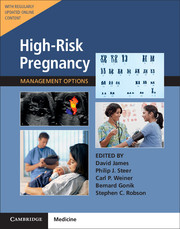Book contents
- Frontmatter
- Contents
- List of Contributors
- Preface
- Section 1 Prepregnancy Problems
- Section 2 Early Prenatal Problems
- Section 3 Late Prenatal – Fetal Problems
- 9 Prenatal Fetal Surveillance
- 10 Fetal Growth Disorders
- 11 Disorders of Amniotic Fluid
- 12 Fetal Hemolytic Disease
- 13 Fetal Thrombocytopenia
- 14 Fetal Cardiac Arrhythmias
- 15 Fetal Cardiac Abnormalities
- 16 Fetal Craniospinal and Facial Abnormalities
- 17 Fetal Genitourinary Abnormalities
- 18 Fetal Gastrointestinal and Abdominal Abnormalities
- 19 Fetal Skeletal Abnormalities
- 20 Fetal Tumors
- 21 Fetal Hydrops
- 22 Fetal Death
- Section 4 Problems Associated with Infection
- Section 5 Late Pregnancy – Maternal Problems
- Section 6 Late Prenatal – Obstetric Problems
- Section 7 Postnatal Problems
- Section 8 Normal Values
- Index
11 - Disorders of Amniotic Fluid
from Section 3 - Late Prenatal – Fetal Problems
- Frontmatter
- Contents
- List of Contributors
- Preface
- Section 1 Prepregnancy Problems
- Section 2 Early Prenatal Problems
- Section 3 Late Prenatal – Fetal Problems
- 9 Prenatal Fetal Surveillance
- 10 Fetal Growth Disorders
- 11 Disorders of Amniotic Fluid
- 12 Fetal Hemolytic Disease
- 13 Fetal Thrombocytopenia
- 14 Fetal Cardiac Arrhythmias
- 15 Fetal Cardiac Abnormalities
- 16 Fetal Craniospinal and Facial Abnormalities
- 17 Fetal Genitourinary Abnormalities
- 18 Fetal Gastrointestinal and Abdominal Abnormalities
- 19 Fetal Skeletal Abnormalities
- 20 Fetal Tumors
- 21 Fetal Hydrops
- 22 Fetal Death
- Section 4 Problems Associated with Infection
- Section 5 Late Pregnancy – Maternal Problems
- Section 6 Late Prenatal – Obstetric Problems
- Section 7 Postnatal Problems
- Section 8 Normal Values
- Index
Summary
Introduction
Amniotic fluid is present from early in pregnancy and is produced almost exclusively by the fetus. It plays an important role in growth, development, and ultimately a good pregnancy outcome:
The main disorders associated with amniotic fluid are:
• excess fluid (polyhydramnios)
• insufficient fluid (oligohydramnios)
Both are associated with adverse pregnancy outcomes.
This chapter will review the basic physiology of amniotic fluid production and content, current methods to measure amniotic fluid, and the two main disorders of amniotic fluid.
Production and Clearance of Amniotic Fluid
Amniotic fluid is produced by different sources through pregnancy, and understanding these sources can help clinicians formulate a differential diagnosis and management plan if abnormalities are noted.
First Trimester
In the first trimester, coelomic fluid is present between the developing chorionic and amniotic membranes. This coelomic fluid disappears completely by the end of the first trimester. Little is known about the production of this fluid, but it is interesting to note that it has a composition more similar to maternal plasma than to amniotic fluid in later pregnancy. The source and mechanisms that regulate the volume and composition of coelomic fluid have not been investigated directly, although the quantity and composition of this fluid have been described extensively, particularly in regard to potential biochemical markers for fetal development.
Second and Third Trimesters
Amniotic fluid begins to be produced early in the second trimester. Initially, it is thought to be produced by three mechanisms:
• direct production from the fetal placental surface
• secretions from the embryo/fetus
• transport across the amnion
Later in the second trimester, amniotic fluid is mainly produced by:
• fetal kidneys
• fetal lungs
It is believed that there are other minor sources of amniotic fluid production, such as secretions from the fetal oral cavity, but these are of little clinical importance.
Amniotic fluid is cleared mainly by fetal swallowing. The integration of production of amniotic fluid and its clearance determines the amount of amniotic fluid at any time. How this delicate balance is maintained is largely unknown.
- Type
- Chapter
- Information
- High-Risk Pregnancy: Management OptionsFive-Year Institutional Subscription with Online Updates, pp. 269 - 280Publisher: Cambridge University PressFirst published in: 2017



